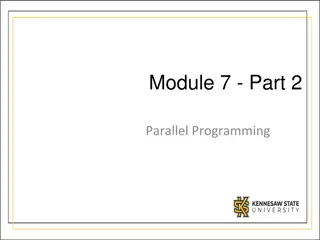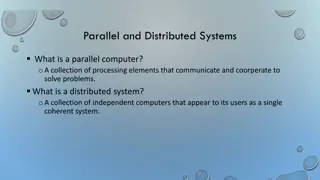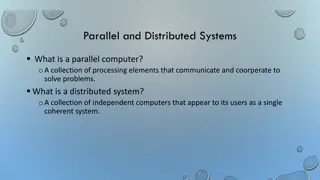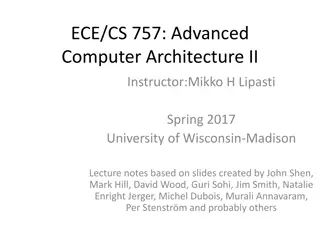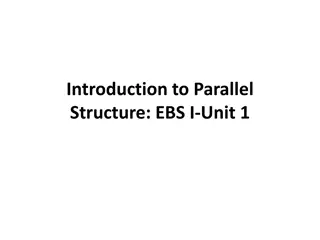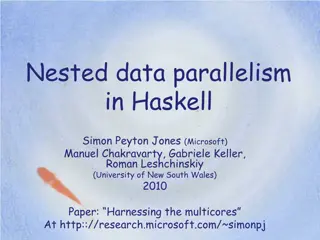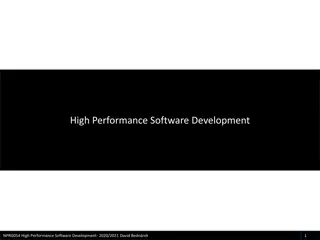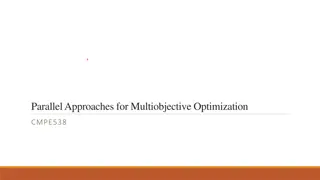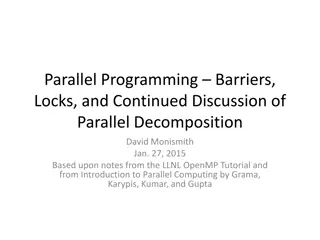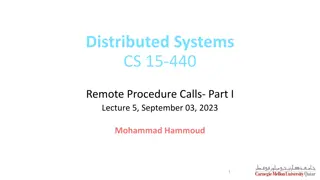Novel Paradigms of Parallel Programming
Dive into the innovative approaches to parallel programming as elucidated by Professor Smruti R. Sarangi from IIT Delhi. The book outlines new paradigms, strategies, and frameworks for designing and optimizing parallel programs. Readers will gain insights into cutting-edge techniques that improve performance, scalability, and efficiency in parallel computing. With a mix of theory and practical examples, this book is a valuable resource for programmers, researchers, and students looking to advance their skills in parallel programming.
Download Presentation

Please find below an Image/Link to download the presentation.
The content on the website is provided AS IS for your information and personal use only. It may not be sold, licensed, or shared on other websites without obtaining consent from the author.If you encounter any issues during the download, it is possible that the publisher has removed the file from their server.
You are allowed to download the files provided on this website for personal or commercial use, subject to the condition that they are used lawfully. All files are the property of their respective owners.
The content on the website is provided AS IS for your information and personal use only. It may not be sold, licensed, or shared on other websites without obtaining consent from the author.
E N D
Presentation Transcript
Novel Paradigms of Parallel Programming Prof. Smruti R. Sarangi IIT Delhi
Outline Multicore Processors Parallel Programming Pardigms Transactional Memory: Basics Software Transactional Memory(STM) Hardware Transactional Memory
Multicores in the last Five Years Source : Intel IDF
Rise and Rise of Multicore Processors According to Moore s Law, the number of cores are doubling each year. Source: extremetech.com
Future of Multicores Cores doubling every two years 16 cores by 2014 32 cores by 2016 64 cores by 2018 Increasing number of threads per core Intel processors 2 threads (hyperthreading mode) IBM Power 7 upto 4 threads per core
Main Challenges Programming and Scaling How to design a system that scales to hundreds of cores? How to program it effectively? Scaling Programming Computer Architects are working on it We need to work on it
Leveraging Multicore Processors Suitable for only desktop applications Each core does a separate job email, editor, music player, video player
What about Enterprise/ Scientific Applications? Need support for parallel programming Traditional Methods Lock based Non-traditional methods Non-blocking methods (lock free/ wait free) Transactional Memory Software Hardware
Outline Multicore Processors Parallel Programming Paradigms Transactional Memory: Basics Software Transactional Memory(STM) Hardware Transactional Memory
Conventional Lock-Based Programming val = account.balance; newval = val + 100; account.balance = newval Can this code be executed in parallel by multiple threads?
What is the problem? 100 200 val = account.balance; newval = val + 100; account.balance = newval 200 val = account.balance; newval = val + 100; account.balance = newval 200 100 200 We need to clearly order one computation before the other Otherwise, the result will be incorrect
Solution: Use Locks lock(); unlock(); val = account.balance; newval = val + 100; account.balance = newval; Problems with Locks Does not allow disjoint access parallelism
What is disjoint access parallelism? Allows code from different threads to run in parallel if they do not access the same data.
Other problems with locks In a typical UNIX futex based implementation If a thread cannot get a lock for 100 s, it invokes the kernel and goes to sleep System calls have an additional overhead They lead to OS jitter, which can be as high as tens of milliseconds [Sarangi and Kallurkar] OS jitter slows down parallel applications by more than 10%
How to get rid of locks? Use the HW instruction CAS (atomic compare and set) Example: CAS a, 10, 5 5 a
Lock free Algorithm while(true) { } <val, ts> = account.balance; newval = val + 100; newts = ts + 1; if (CAS (account.balance, <val,ts>, <newval,newts>) ) break; account.balance value timestamp
Issues with the Lockfree Algorithm The loop might never terminate Can lead to starvation There are two metrics that we need to optimize speed fairness
How to increase the balance? Wait free algorithms Basic Idea A request, T, first finds another request, R, that is waiting for a long time T decides to help R This strategy ensures that no request is left behind Also known as an altruistic algorithm
Support Required dcas (double CAS) instruction dcas(a, v1, v2, b, v3, v4) Atomic if ((a = v1), and (b = v3)) set a = v2 set b = v4
Implementation of a Wait Free Algorithm repeat until (R = null) R = needsHelp(); if (R != null) help (R); help (T) help(T) while(true) { } <val, ts> = T.account.balance; newval = val + 100; newts = ts + 1; if (dcas (T.account.balance, <val,ts>, <newval,newts>, T.status, 0, 1) ) break; if(T.status == 1) break;
Issues in implementing a wait free algorithm The dcas instruction is not available on most machines Possible to implement it with regular cas instructions Wait free algorithms are thus very complicated speed fairness
Implementing a wait free algorithm is the same as A black belt in programming
Outline Multicore Processors Parallel Programming Paradigms Transactional Memory: Basics Software Transactional Memory(STM) Hardware Transactional Memory
Transactional Memory (TM) What is the best way to achieve both speed and fairness? Try transactional memory: begin(atomic) { val = account.balance; newval = val + 100; account.balance = newval; }
Advantages Easy to program Tries to provide the optimal fairness and speed Similar to database transactions ACID (atomic, consistent, isolated, durable) Software TM Hardware TM
Basics of Transactional Memory Notion of a conflict Two transactions conflict, when there is a possibility of an error, if they execute in parallel Formally: write set read set set of variables that are read by the transaction set of variables that are written by the transaction
When do transactions conflict? Let Ri and Wi, be the read and write sets of transaction, i Similarly, let Rj and Wj be the read and write sets of transaction, j There is a conflict iff: Wi Wj Wi Rj OR Ri Wj
Abort and Commit Commit A transaction completed without any conflicts Finished writing its data to main memory Abort A transaction could not complete due to conflicts Did not make any of its writes visible
Basics of Concurrency Control A conflict occurs when the read-write sets overlap A conflict is detected when the TM system becomes aware of it A conflict is resolved when the TM system either delays a transaction aborts it occurrence detection resolution
Pessimistic vs Optimistic Concurrency Control occurrence, detection, resolution pessimistic concurrency control detection resolution occurrence optimistic concurrency control
Version Management Eager version management Write directly to memory Maintain an undo log writeback undo log commit abort flush undo log Lazy version management Write to a buffer (redo log) Transfer the buffer to memory on a commit writeback redo log commit abort flush redo log
Conflict Detection Eager Check for conflicts as soon as a transaction accesses a memory location Lazy Check at the time of committing a transaction
Semantics of Transactions Serializable Transactions can be ordered sequentially Strictly Serializable The sequential ordering is consistent with the real time ordering Linearizable A transaction appears to execute instantaneously Opacity A transaction is strictly serializable with respect to non-transactional accesses also
What happens after an abort? The transaction restarts and re-executes Might wait for a random duration of time to minimize future conflicts do { } while (! Tx.commit())
Outline Multicore Processors Parallel Programming Pardigms Transactional Memory: Basics Software Transactional Memory(STM) Hardware Transactional Memory
Software Transactional Memory choices Concurrency Control Optimistic or Pessimistic Version Management Lazy or Eager Conflict Detection Lazy or Eager
Support Required Augment every transactional object/ variable with meta data object 1. Transaction that has locked the object 2. Read or write object metadata
Maintaining Read Write Sets Each transaction maintains a list of locations that it has read in the read-set written in the write-set Every memory read or write operation is augmented readTX (read, and enter in the read set) writeTX(write, and enter in the write set, make changes to the undo/redo log)
Bartok STM Every variable has the following fields version value lock value version Transactional Variable
Read Operation Read Operation Record the version of the variable Add the variable to the read set Read the value
Write Operation Lock the variable Abort if it is already locked Add the old value to the undo log Write the new value
Commit Operation For each entry in the read set Check if the version of the variable is still the same Yes No Abort For each entry in the write set Increment the version Release the lock
Pros and Cons does not provide opacity simple reads are simple uses locks provide a strong semantics for transactions
TL2 STM Uses lazy version management redo log Uses a global timestamp Provides strong guarantees with respect to other transactions, and even operations that are not within the context of a transaction Locks variables only at commit time Every transaction tX has a unique version (tx.V) that is assigned to it when it starts
Read Operation Read Operation read (tX, obj) obj in the redo log Return value in the redo log No Yes v1 = obj.timestamp result = obj.value v2 = obj.timestamp if( (v1 != v2) || (v1 > tX.V) || obj.lock) abort(); addToReadSet(obj); return result;
Write Operation Add entry to the redo log if required Perform the write
Commit Operation For each entry in the write set failure abort Lock object version globalClock + 1 For each entry e in the read set failure abort if (e.version > tx.V) writeback redo log set the version, undo lock For each entry in the write set
Pros and Cons simple A redo log is slower provides opacity uses locks holds locks for a lesser amount of time
Outline Multicore Processors Parallel Programming Pardigms Transactional Memory: Basics Software Transactional Memory(STM) Hardware Transactional Memory
Hardware Transactional Memory pessimistic concurrency control eager conflict detection lazy version management Processor Processor Processor Augment with a speculative bit L1 Cache L1 Cache L1 Cache L2 Cache











